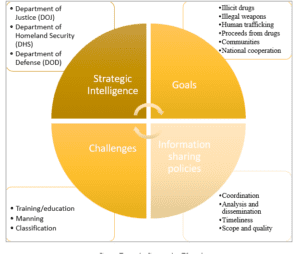Enhancing All-Domain Awareness- Cross-Domain Strategies and Partnerships for Homeland Security at the Southwest Border
Cross-Domain Strategies Planning
The planning process when implementing cross-domain strategies cannot overlook the available intelligence that the NSWBCN Strategy relies upon. The level of security threat that the Southwest Border opposes to the United States demands an aggressive approach to dealing with the issue. The current strategy relies on more than 250 task forces as well as intelligence fusion units. The main collaborative unit is the Border Intelligence Fusion Section (BIFS), which was set up in 2010. It comprises the Departments of Justice, Homeland Security, and Defense. The main intention is to ensure that the stakeholders have access to fused intelligence as well as tactical information, which supports law enforcement activities, investigations, and operations. However, the disbandment of BIFS three years after its formation highlighted critical aspects that need extra attention when using a similar approach (Ricklefs, 2015). To successfully utilize the cross-domain approach, it is important to anticipate friction, gradual problem solving, set up good execution plans, and selectable leaders. These aspects ensure the successful collaboration of different agencies.
The goals that the NSWBCN strategy intends to attain matter to cross-domain strategies. The strategy’s goals encompass interdiction of illicit drugs, weapons, and proceeds from the same, curbing human trafficking, gaining cooperation between Mexico and the United States on managing the security threat, strengthening the nearby communities for resilience, and ensuring that these elements pose minimal threat to the United States. These goals guide the cross-domain strategy through the identification of the best agencies to carry out each role (Highlights: National Southwest Border Counternarcotics Strategy, 2011). Therefore, the goals not only determine the necessary intelligence but also the agencies that will be involved in the process from the private and public sectors.
Information sharing is critical to the success of the cross-domain strategy that NSWBCN may choose to adopt. Information is shared among the involved agencies and between countries that face a common security threat. The most important aspects include the quality of intelligence, scope, timeliness, and analysis of the information. Failure to clearly state these aspects and subsequently observe each interferes with the process of coordination. Finally, cross-domain strategies must encounter challenges that are related to a lack of sufficient knowledge and insufficient operation. These challenges are likely to result in friction and affect the synergy negatively (J7, 2016). Training and education are one the ways to solve these challenges because it instills skills and knowledge.
References
Highlights: National Southwest Border Counternarcotics Strategy. (2011). Retrieved from https://www.ojp.gov/pdffiles1/ondcp/swb_counternarcotics_summary11.pdf
J7. (2016). Cross-Domain Synergy in Joint Operations. Retrieved from https://www.jcs.mil/Portals/36/Documents/Doctrine/concepts/cross_domain_planning_guide.pdf?ver=2017-12-28-161956-230
Ricklefs, R. (2015). The Border Intelligence Fusion Section: Perspectives on Joint Interagency Intelligence Collaboration along the U.S. Southwest Border. CSIR Research. Retrieved from https://ni-u.edu/research/Research_Report_Oct2015_
ORDER A PLAGIARISM-FREE PAPER HERE
We’ll write everything from scratch
Question
Examine the potential for public or private partnerships and interagency efficiencies in addressing All-Domain Awareness (ADA) challenges and coordinated efforts in the land, air, maritime, and cyber domains in the unique homeland security environment of the Southwest border (SWB).
Enhancing All-Domain Awareness- Cross-Domain Strategies and Partnerships for Homeland Security at the Southwest Border
Although this strategy has a counternarcotics focus, the SWB represents a multi-threat, multidomain, multiagency challenge that poses significant challenges for homeland security planners because of the asymmetric and interconnected nature of regional crime networks and cross-border violence. For this assignment, complete the following:
Prepare a 1-page quad chart and a 1-page supporting document that explains the planning variables associated with cross-domain strategies.
Draw heavily from the relevant chapters of the NSWBCN Strategy, leveraging the substantive work that has been done by policymakers at the national level.
Section 8: International Factors
This week, you will identify and detail the potential international players, including the role of the Department of State, President Obama’s SWB Security Bill, the Merida Initiative, and support by nongovernmental organizations (NGOs), along with counterparts in Mexico.


